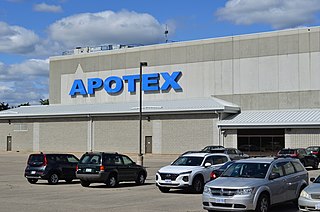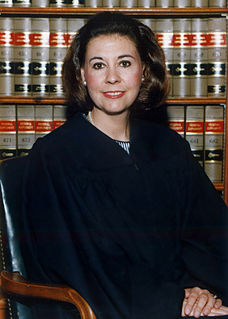
Sildenafil, sold under the brand name Viagra among others, is a medication used to treat erectile dysfunction and pulmonary arterial hypertension. It is unclear if it is effective for treating sexual dysfunction in women. It is taken by mouth or by injection into a vein. Onset is typically within 20 minutes and lasts for about 2 hours.
Novelty is a requirement for a patent claim to be patentable. An invention is not new and therefore not patentable if it was known to the public before the filing date of the patent application, or before its date of priority if the applicant claims priority of an earlier patent application. The purpose of the novelty requirement is to prevent prior art from being patented again.
The inventive step and non-obviousness reflect a general patentability requirement present in most patent laws, according to which an invention should be sufficiently inventive—i.e., non-obvious—in order to be patented. In other words, "[the] nonobviousness principle asks whether the invention is an adequate distance beyond or above the state of the art".

Apotex Inc v Wellcome Foundation Ltd, [2002] 4 S.C.R. 153, is a leading Supreme Court of Canada decision on the utility requirement for a patent in Canada. The Court rejected a challenge by the generic drug manufacturers Novopharm and Apotex to declare Glaxo Wellcome's patent for AZT, an AIDS-fighting drug, invalid.

Apotex Inc. is a Canadian pharmaceutical corporation. Founded in 1974 by Barry Sherman, the company is the largest producer of generic drugs in Canada, with annual sales exceeding CA$1 billion. By 2016, Apotex employed over 10,000 people as one of Canada's largest drug manufacturers, with over 300 products selling in over 115 countries. Revenues were about CA$1.19 billion annually. Apotex manufactures and distributes generic medications for a range of diseases and health conditions that include cancer, diabetes, high cholesterol, glaucoma, infections and blood pressure.

Canadian patent law is the legal system regulating the granting of patents for inventions within Canada, and the enforcement of these rights in Canada.
Anderson's-Black Rock, Inc. v. Pavement Salvage Co., 396 U.S. 57 (1969), is a 1969 decision of the United States Supreme Court on the legal standard governing the obviousness of claimed inventions. It stands for the proposition that, when old elements are combined in a way such that they do not interact in a novel, unobvious way, then the resulting combination is obvious and therefore unpatentable.

Rebecca Beach Smith is a Senior United States District Judge of the United States District Court for the Eastern District of Virginia and a civic leader. Among her many decisions is the 2011 ruling that decided the title to and restrictions upon artifacts salvaged from the wreck of the RMS Titanic.

In Canada, every patent application must include the “specification”. The patent specification has three parts: the disclosure, the claims, and the abstract. The contents of the specification are crucial in patent litigation.

For a patent to be valid in Canada, the invention claimed therein needs to be new and inventive. In patent law, these requirements are known as novelty and non-obviousness. A patent cannot in theory be granted for an invention without meeting these basic requirements or at least, if a patent which does not meet these requirements is granted, it cannot later be maintained. These requirements are borne out of a combination of statute and case law.

A patent holder in Canada has the exclusive right, privilege and liberty to making, constructing, using and selling the invention for the term of the patent, from the time the patent is granted. Any person who does any of these acts in relation to an invention without permission of the patent owner is liable for patent infringement.

Once an invention is patented in Canada, exclusive rights are granted to the patent holder as defined by s.42 of the Patent Act. Any interference with the patent holder's "full enjoyment of the monopoly granted by the patent" is considered a patent infringement. Making, constructing, using, or selling a patented invention without the patent holder's permission can constitute infringement. Possession of a patented object, use of a patented object in a process, and inducement or procurement of an infringement may also, in some cases, count as infringement.

In Canadian patent law, only “inventions” are patentable. Under the Patent Act, only certain categories of things may be considered and defined as inventions. Therefore, if a patent discloses an item that fulfills the requirements of novelty, non-obviousness and utility, it may nonetheless be found invalid on the grounds that it does not fall within one of the statutory categories of “invention”. Since the Patent Act, the categories of patentable subject matter have been defined and interpreted by Canadian courts.

Apotex Inc v Sanofi-Synthelabo Canada Inc, [2008] 3 S.C.R. 265, is a leading Supreme Court of Canada decision on the novelty and non-obviousness requirements for a patent in Canada. The Court rejected a challenge by the generic drug manufacturer Apotex to declare Synthelabo Canada's patent for Plavix, an anti-coagulant drug, invalid. At issue was whether selection patents are invalid in principle, and if they are not, whether the subject selection patent was invalid on the grounds of anticipation, obviousness or double patenting.

Tennessee Eastman Co v Canada , [1974] S.C.R. 111, is a leading Supreme Court of Canada authority for the proposition that medical or therapeutic methods are not patentable in Canada.

Canada v GlaxoSmithKline Inc is the first ruling of the Supreme Court of Canada that deals with issues involving transfer pricing and how they are treated under the Income Tax Act of Canada ("ITA").

Ciba-Geigy Canada Ltd. v. Apotex Inc., [1992] 3 SCR 120, is a Supreme Court of Canada judgment on trademark law and more specifically the issue of passing off. Ciba-Geigy brought an action against Apotex and Novopharm, alleging that their versions of the prescription drug metoprolol were causing confusion to the public due to their similar appearance to Ciba-Geigy's version of the drug Lopresor. On appeal to the SCC, the issue was whether a plaintiff is required to establish that the public affected by the risk of confusion includes not only health care professionals but also the patients who consume the drugs in a passing off action involving prescription drugs of a similar appearance. The Supreme Court held affirmatively on this question.
Neither computers nor software are specifically mentioned in the Canadian Patent Act. Canadian courts have held that the use of a computer in an invention neither lends, nor reduces patentability. Therefore, that an invention involves a computer is not determinative of patentability; instead, whether a computer-using invention is patentable turns on whether that invention meets the general requirements for patentability as would apply to any invention.
Alice Corp. v. CLS Bank International, 573 U.S. 208 (2014), was a 2014 United States Supreme Court decision about patent eligibility. The issue in the case was whether certain patent claims for a computer-implemented, electronic escrow service covered abstract ideas, which would make the claims ineligible for patent protection. The patents were held to be invalid because the claims were drawn to an abstract idea, and implementing those claims on a computer was not enough to transform that abstract idea into patentable subject matter.
Teva Pharmaceuticals USA, Inc. v. Sandoz, Inc., 574 U.S. 318 (2015), is a landmark patent Supreme Court case disputing over the Copaxone patent. The Court held that, when reviewing a district court’s resolution of subsidiary factual matters made in the course of its construction of a patent claim, the Federal Circuit must apply a "clear error," not a de novo, standard of review.







